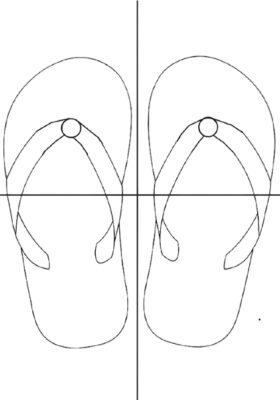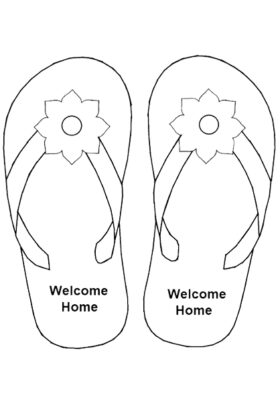Flip flops are a popular footwear choice, especially during the summer months. Drawing flip flops can be a fun and creative activity that allows you to showcase your artistic skills. How to draw flip flops? this step-by-step guide will walk you through the process of drawing flip flops with ease. By following these simple instructions and practicing regularly, you’ll be able to create realistic and eye-catching flip flop illustrations in no time.
How to Draw a Flip Flops Step By Step Easy For Kids

Step 1: Outline the Shape of the Flip Flops

Start by lightly sketching the outline of the flip flops using a pencil. Begin with a curved line that represents the sole of the flip flop. Then, draw a slightly curved line on top to represent the strap. The strap should start from one side of the sole, arch over the foot, and connect to the other side of the sole. Remember to keep your lines light and loose at this stage, as you can refine them later.
Step 2: Refine the Shape and Add Details

Once you’re satisfied with the basic outline, refine the shape of the flip flops by adding more definition. Smooth out the curves and make the lines more prominent. Pay attention to the curves and contours of the sole, ensuring they are symmetrical. Next, add some thickness to the strap to make it more realistic.
To add more depth and dimension, sketch the footbed of the flip flop. It usually has a textured pattern, such as ridges or dots. Carefully observe reference images or real flip flops to replicate these patterns accurately. Don’t worry if your lines aren’t perfect; a bit of irregularity can add character to your drawing.
Step 3: Erase Unnecessary Lines

Now it’s time to clean up your drawing. Erase any unwanted guidelines or extra lines that are no longer needed. Be gentle while erasing to avoid damaging the paper. Use a kneaded eraser if you want to remove smaller or more delicate lines without smudging.
Step 4: Final Touches and Details

Now that you’ve added colors and shading, take a moment to review your drawing. Make any necessary adjustments or touch-ups to enhance the overall appearance. Pay attention to details such as texture, highlights, and reflections to make your flip flops look more realistic.
Step 5: Add Colors and Shading

This step is optional but can make your drawing more vibrant and appealing. Use colored pencils or markers to add colors to your flip flops. Consider the color scheme you want to use and apply it to the sole, strap, and footbed. Experiment with different shades to achieve a realistic look.
To add depth and make your flip flops appear three-dimensional, incorporate shading. Identify a light source in your drawing, and imagine where the shadows would fall. Shade accordingly, using darker tones where shadows are cast and lighter tones where light hits the flip flops. Gradually build up the shading to achieve a smooth transition between light and dark areas.
Tip On How to Draw Flip Flops
- Focus on Basic Shapes: When starting to draw flip flops, break down the shape into basic geometric forms. Begin by sketching the sole of the flip flop as an oval or rounded rectangle. Then, add a curved line on top to represent the strap. By simplifying the shapes, it becomes easier to establish the overall structure and proportions of the flip flops.
- Once you have the basic shapes in place, you can refine them by adding more details and curves to create a realistic look. Pay attention to the curves of the sole and strap, ensuring they flow naturally. Remember to keep your lines light and loose during the initial sketching phase, as you can go back and refine them later.
- By focusing on basic shapes, you can build a solid foundation for your flip flop drawing and have an easier time adding more intricate details and textures afterward. Practice regularly and experiment with different styles and perspectives to enhance your drawing skills further.
FAQs On How to Draw Flip Flops
Q: I’m a beginner in drawing. Are flip flops a good starting point?
A: Flip flops can be an excellent subject for beginners. They have simple shapes and lines, making them a great starting point to practice basic drawing techniques. By following step-by-step instructions and using reference images, you can gradually develop your skills and gain confidence in drawing more complex subjects.
Q: Do I need any specific drawing materials to draw flip flops?
A: To draw flip flops, you will need some basic drawing materials such as a pencil, eraser, and paper. These tools are sufficient for creating a simple flip flop illustration. If you want to add colors, you can also use colored pencils or markers. However, these additional materials are optional, and you can create a beautiful flip flop drawing with just a pencil and paper.
Q: I struggle with getting the proportions right. Any tips?
A: Proportions are essential in achieving a realistic drawing. To ensure accurate proportions of your flip flops, you can use the following tips:
- Observe: Pay close attention to the reference images or real flip flops you’re using as a guide. Notice the relationships between different parts, such as the size of the strap compared to the sole and the distance between the strap and the sole.
- Break it down: Mentally divide the flip flop into basic shapes. For example, you can see the sole as an oval or a rounded rectangle, and the strap as a curved line. Start by sketching these basic shapes lightly and then refine them.
- Measure: Use your pencil as a measuring tool. Hold it up and compare the size of different parts of the flip flop. For example, you can check how many “pencil lengths” the strap is in relation to the sole. This technique can help you maintain proportion and balance in your drawing.
Q: How can I make my flip flop drawing look more realistic?
A: To make your flip flop drawing look more realistic, consider these tips:
- Details: Pay attention to the smaller details, such as the texture on the footbed or any logo or design on the strap. Adding these details will bring more authenticity to your drawing.
- Shadows and Shading: Incorporate shadows and shading to give your flip flops depth and dimension. Identify a light source in your drawing and imagine where the shadows would fall. Use darker tones in the shadowed areas and lighter tones where light hits the flip flops. Gradually build up the shading to create a smooth transition.
- Reflections: If you’re drawing flip flops on a shiny surface, like water or a polished floor, consider adding reflections. These reflections can be subtle and help create a more realistic and dynamic look.
- Remember to practice regularly, study real flip flops or reference images, and pay attention to the details. With time and practice, your flip flop drawings will become more lifelike and impressive.
Q: Are there any online tutorials or resources that can help me learn to draw flip flops?
A: Yes, there are numerous online tutorials and resources available to help you learn how to draw flip flops. You can find step-by-step video tutorials on platforms like YouTube, where artists demonstrate the process of drawing flip flops. Additionally, websites and blogs dedicated to art and drawing often provide detailed tutorials and tips for drawing various subjects, including flip flops.
Your Flip Flops is Completed!
Drawing flip flops can be a delightful and rewarding artistic endeavor. By following these easy step-by-step instructions, you can create your own stunning flip flop illustrations. Remember, practice makes perfect, so keep honing your skills and exploring different techniques. Don’t
